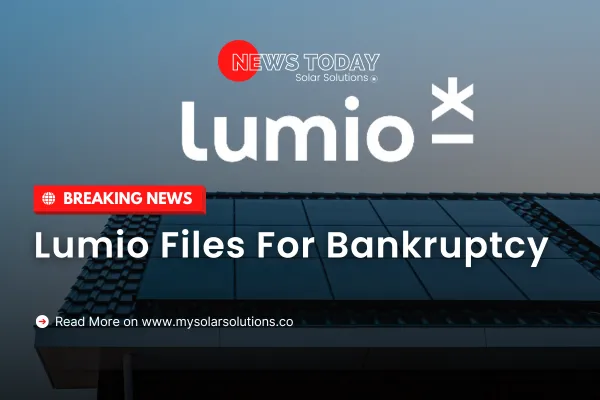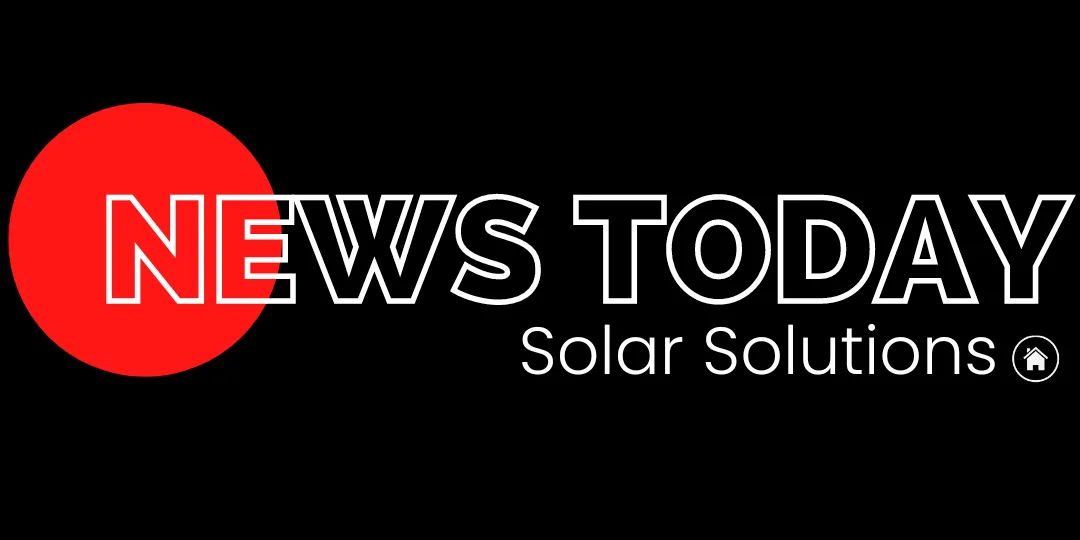The Solar Industries Trusted News Source
Solar News Today
Transparent Reporting for a Sustainable Future
Latest News Stories

Lumio Files for Bankruptcy: What This Means for the Solar Industry
In a surprising twist for the residential solar market, Lumio has officially filed for Chapter 11 bankruptcy just three years after its inception. This news highlights not only the challenges faced by new entrants in the solar space but also the intricate dynamics at play in the renewable energy sector. As we unpack the implications of Lumio's bankruptcy filing, let's take a closer look at what led to this moment and what it means for both the company and its customers.
Understanding Lumio's Bankruptcy Filing
What is Chapter 11 Bankruptcy?
Before diving deeper, it's essential to understand what Chapter 11 bankruptcy entails. Here’s a quick breakdown:
Reorganization: Companies can restructure their debts while continuing their operations.
Protection: Protects the company from creditors during the reorganization process.
Timeframe: Usually lasts several months as the company seeks to stabilize.
In Lumio's case, this filing indicates an opportunity for them to reorganize effectively while retaining their operations.
Reasons Behind the Filing
So, why did Lumio, which was once on the fast track, hit such a significant bump in the road? Here are some potential causes:
Market Competition: The solar industry is becoming increasingly crowded, making it challenging for new players to carve out a niche.
Economic Pressures: Rising costs of materials and installation affect profit margins.
Regulatory Challenges: Changes in legislation or policy can significantly impact operations.
Understanding these factors is crucial for anyone involved in or considering the solar industry.
What Happens Next for Lumio?
Stalking Horse Asset Purchase Agreement
Interestingly, prior to their bankruptcy filing, Lumio entered into a stalking horse asset purchase agreement with White Oak Global Advisors. This deal stipulates that White Oak will acquire nearly all of Lumio’s assets for a remarkable $100 million.
Key Points of the Agreement
Strategic Move: This acquisition is designed to lay a solid groundwork for Lumio's future.
Support System: The backing of White Oak aims to enhance Lumio's financial stability.
Preserving Operations: The company intends to continue business as usual during the bankruptcy process.
Andrew Walton, the CEO of Lumio, emphasized that this move is a stepping stone toward strengthening their position in the market. He stated their commitment to providing top-notch service as they evolve.
Temporary Operations
In the face of these challenges, Lumio has filed customary “first day” motions, which are designed to ensure that operations won’t be disrupted during this transitional phase. This move brings some reassurance to both customers and employees that Lumio will continue to serve their needs.
The Broader Implications for the Solar Industry
Impact on Customers
For Lumio's existing customers, this news might raise concerns. However, here's what we believe will happen:
Continued Service: Customers can expect that Lumio will fulfill existing contracts and service agreements as they navigate their transition.
Opportunity for Improvements: With new ownership, there may be enhancements to service delivery and operational efficiencies.
Market Landscape Shift
The solar industry continues to evolve, combining opportunity with uncertainty. Lumio's bankruptcy is a reminder that even promising companies can face hurdles. After all, the renewable energy sector is not immune to economic fluctuations and market conditions.
The Growth of Competitors
Established Players: Bigger companies may capitalize on Lumio's challenges, capturing market share.
Innovation: Other solar installers may innovate and improve services, ultimately benefiting the sector through competition.
Investor Insights
For investors monitoring the solar marketplace, Lumio’s situation presents mixed signals. On one hand, there's a potential for lucrative opportunities if Lumio's restructuring leads to a stronger, more efficient company. On the other hand, it underscores the inherent risks of investing in newer companies within a competitive landscape.
Looking Ahead: Future of Solar Industry
As we look to the future, a few key considerations emerge regarding the solar industry:
Sustainability Focus
Renewable Growth: Despite challenges, the renewable energy sector is projected to grow. Lumio’s restructure might inspire other companies to innovate and adapt in a similar fashion.
Policy Support: Government incentives and policies favoring renewable energy could bolster market stability.
Technological Advancements
Battery Storage: Advancements in solar technology and battery storage solutions will continue to reshape consumer options.
Cost Efficiency: As technology improves, installation costs may decrease, increasing accessibility for homeowners interested in going solar.
Consumer Education
As the solar market becomes more competitive, consumer education will be vital. Homeowners need to understand their options fully, from installation costs to financing or leasing arrangements. Companies like Lumio, even amid challenges, play a crucial role in guiding consumers through these options.
Overall, Lumio’s bankruptcy filing illuminates the precarious nature of the solar industry, particularly for new entrants. While this news is certainly concerning, it's also a unique opportunity for Lumio to realign and strengthen its operations under new ownership. Consumers can expect continuity in service, while the broader industry will continue to evolve, driven by innovation and competition.
As we move forward, it's crucial for stakeholders in the solar sector to remain vigilant, adaptable, and informed.
FAQs
What is Chapter 11 bankruptcy?
Chapter 11 bankruptcy allows individuals or businesses to reorganize their debts while continuing to operate.
How will Lumio’s bankruptcy affect its customers?
Customers can expect ongoing service and support during Lumio's restructuring process.
What does the asset purchase agreement involve?
White Oak Global Advisors plans to acquire nearly all of Lumio’s assets for $100 million, supporting Lumio's growth.
Is this the end for Lumio?
Not necessarily. The bankruptcy can provide Lumio with a chance to rebuild and strengthen its operations.
What is the outlook for the solar industry?
Despite challenges like Lumio's bankruptcy, the renewable energy sector is expected to grow as technology improves and consumer demand increases
MEET THE FOUNDER & CEO
Hey, I'm Kiara!
I bring over a decade of experience in the solar industry, combined with a background in Journalism, to inform and empower others.
As the founder of the largest virtual solar brokerage in America, my mission is to provide transparency and clarity to the world of renewable energy.
Welcome to the news page of My Solar Solutions, your premier source for comprehensive solar news in the United States. We are dedicated to delivering the latest insights, updates, and innovations from the solar energy sector. As the nation's go-to platform for solar information, we cover everything from cutting-edge technologies to policy changes and market trends, ensuring that our audience stays informed and empowered to make decisions about renewable energy
Why Solar News Matters
The solar industry is a dynamic and rapidly evolving field. From breakthroughs in photovoltaic technology to shifts in government incentives, staying updated is essential for homeowners, businesses, and industry professionals alike. Solar energy is at the forefront of the global transition to sustainable power, making it a key player in addressing climate change and reducing reliance on fossil fuels. At My Solar Solutions, we recognize the critical role that information plays in shaping this transition. By providing reliable, accurate, and timely news, we aim to be the trusted source for anyone seeking to understand or engage with the solar industry. Whether you're a homeowner considering solar panels, a business exploring energy-saving solutions, or an enthusiast keen on the latest trends, our news page has something for you.

What We Cover...

Technological Innovations
Solar technology is advancing at an unprecedented pace. Our news page features updates on groundbreaking developments, including:
High-efficiency panels: Learn about the latest solar panels, including advancements in materials like perovskite and bifacial designs.
Energy storage: Discover innovations in battery technologies that enhance the reliability and scalability of solar systems.
Smart grids: Stay informed about how solar integrates with smart grid systems to optimize energy distribution.

Market Trends and Analysis
Understanding market dynamics is crucial for anyone involved in solar energy. Our articles delve into:
Solar adoption rates: Explore data on how solar installations are growing across residential, commercial, and industrial sectors.
Pricing trends: Get insights into the costs of solar panels, inverters, batteries, and installation services.
Investment opportunities: Stay ahead with information about renewable energy stocks, tax credits, and financial incentives.

Policy and Legislation
Solar energy thrives on supportive policies. Our coverage includes:
Federal and state incentives: Learn about tax credits, rebates, and grants available to solar adopters.
Regulations: Understand net metering policies, permitting processes, and compliance requirements.
Global policies: Discover how international agreements and policies impact the U.S. solar industry.

Environmental Impact
Solar energy plays a pivotal role in reducing greenhouse gas emissions and combating climate change. Our content highlights
Carbon savings: Quantify the environmental benefits of switching to solar energy.
Sustainability practices: Explore how solar aligns with broader environmental and sustainability goals.
Case studies: Read about successful projects that showcase the positive impact of solar energy on communities and ecosystems.

Solar Success Stories
Real-world applications of solar energy inspire and inform. We feature:
Residential installations: See how homeowners are transforming their energy usage with solar panels.
Business case studies: Learn about companies leading the charge in renewable energy adoption.
Community projects: Discover how solar energy is empowering underserved regions and creating jobs.

Challenges and Solutions
While solar energy offers numerous benefits, challenges remain. We address issues like:
Grid reliability: Explore how solar interacts with aging grid infrastructure.
Material sourcing: Understand the sustainability concerns related to raw materials for solar panels and batteries.
End-of-life management: Learn about recycling and disposal solutions for solar equipment.
Why Choose My Solar Solutions for Your Solar News?
We take pride in delivering:
Expertise: With over a decade of experience in the solar industry, we bring unparalleled knowledge to our reporting.
Accuracy: Our content is meticulously researched and verified to ensure reliability.
Relevance: We focus on topics that matter most to our audience, from homeowners to industry professionals.
Our commitment to quality has earned us a reputation as the authoritative source for solar news in the U.S. By choosing My Solar Solutions, you are choosing a partner dedicated to your energy independence and environmental stewardship
Our Vision For The Future
At My Solar Solutions, our vision extends beyond providing news. We aim to:
Advocate for policy changes: Support initiatives that make solar energy more accessible and affordable.
Drive innovation: Partner with industry leaders to bring the latest technologies to market.
Promote sustainability: Champion practices that prioritize environmental health and resource conservation.
By aligning with these goals, we strive to create a platform that not only informs but also inspires action.


Facebook
Instagram
X
Youtube